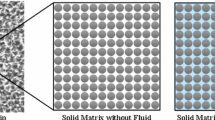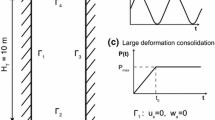Abstract
This paper aims to present a coupled solution strategy for the problem of seepage through a rockfill dam taking into account the free-surface flow within the solid as well as in its vicinity. A combination of a Lagrangian model for the structural behavior and an Eulerian approach for the fluid is used. The particle finite element method is adopted for the evaluation of the structural response, whereas an Eulerian fixed-mesh approach is employed for the fluid. The free surface is tracked by the use of a level set technique. The numerical results are validated with experiments on scale models rockfill dams.
Similar content being viewed by others
References
Adam D, Wood W (1983) Comparison of Hilber–Hughes–Taylor and Bossak α methods for the numerical integration of vibration equations. Int J Numer Methods Eng 19: 765–771
Biot M (1941) General theory of three dimensional consolidation. J Appl Phys 12: 155–164
de Boer R (2000) Theory of porous media. Springer, Berlin
Carbonell J, Oñate E, Suárez B (2008) Modeling of ground exavation with the particle finite element method (pfem). ASCE J Eng Mech 136: 455–463
Codina R (2000) A nodal-based implementation of a stabilized finite element method for incompressible flow problems. Int J Numer Methods Fluids 33: 737–766
Codina R (2000) Pressure stability in fractional step finite element methods for incompressible flows. J Comput Phys 170: 112–140
Codina R, Soto O (2004) Approximation of the incompressible Navier-Stokes equations using orthogonal subscale stabilization and pressure segregation on anisotropic finite element meshes. Comput Methods Appl Mech Eng 193: 1403–1419
Cremonesi M, Frangi A, Perego U (2011) A lagrangian finite element approach for the simulation of water-waves induced by landslides. Comput Struct 89: 1086–1093
Dadvand P, Rossi R, Oñate E (2010) An object-oriented environment for developing finite element codes for multi-disciplinary applications. Arch Comput Methods Eng 17: 253–297
Hsu MC, Bazilevs Y, Calo V, Tezduyar TE, Hughes T (2010) Improving stability of stabilized and multiscale formulations in flow simulations at small time steps. Comput Methods Appl Mech Eng 199: 828–840
ICOLD (1995) Bulletin 99, dam failures statistical analysis. ICOLD, Paris
Larese A (2012) A coupled Eulerian–PFEM model for the simulation of overtopping in rockfill dams. PhD Thesis. Universitat Politècnica de Catalunya. UPC BarcelonaTech, Barcelona
Larese A, Rossi R, Oñate E, Idelsohn S (2008) Validation of the particle finite element method (PFEM) for simulation of free surface flows. Eng Comput 25: 385–425
Lewis R, Schrefler B (1998) The finite element method for the static and dynamic deformation and consolidation of porous media. Wiley, New York
Lipscomb G, Denn M (1984) Flow of a bingham fluid in complex geometries. J Non Newtonian Fluid Mech 14: 337–346
Marti J, Ryzhakov P, Idelsohn S, Oñate E (2012) Combined Eulerian–PFEM approach for analysis of polymers in fire situations. Int J Numer Methods Eng 81(2): 135–268
Mier M, Idelsohn S, Oñate E (2010) Advances in the simulation of multi-fluid flows with the particle finite element method. Int J Numer Methods Fluids 67: 1516–1539
Mossaiby F, Rossi R, Dadvand P, Idelsohn S (2011) OpenCL-based implementation of an unstructured edge-based finite element convection–diffusion solver on graphics hardware. Int J Numer Methods Eng 89(13): 1635
Nield D, Bejan A (1992) Convection in porous media. Springer, New York
Nithiarasu P, Seetharamu K, Sundararajan T (1997) Natural convective heat transfer in a fluid saturated variable porosity medium. Int J Heat Mass Transf 40: 3955–3967
Coussy O (1995) Mechanics of porous media. Wiley, New York
Oñate E, Celigueta M, Idelsohn S, Salazar F, Suarez B (2011) Possibilities of the particle finite element method for fluid–soil-structure interaction problems. J Comput Mech 48: 307–318
Oñate E, Idelsohn S, Celigueta M, Rossi R (2008) Advances in the particle finite element method for the analysis of fluid multibody interaction and bed erosion in free surface flows. Comput Methods Appl Mech Eng 197: 1777–1800
Oñate E, Idelsohn S, Celigueta M, Rossi R, Marti J, Carbonell J, Ryzakov P, Suárez B (2011) Advances in the particle finite element method (PFEM) for solving coupled problems in engineering. In: Oñate E, Owen R (eds) Particle-based methods, computational methods in applied sciences, vol 25. Springer, New York
Oñate E, Idelsohn S, Pin FD, Aubry R (2004) The particle finite element method an overview. Int J Comput Methods 1: 267–307
Osher S, Fedkiw RP (2003) Level set methods and dynamic implicit surfaces. Springer, New York
Papanastasiou TC (1987) Flows of materials with yield. J Rheol 31: 385–404
Quecedo M, Pastor M, Herreros M, Merodo JF (2004) Numerical modelling of the propagation of fast landslides using the finite element method. Int J Numer Methods Eng 59: 755–794
Rojek J, Labra C, Su O, Oñate E (2012) Comparative study of different discrete element models and evaluation of equivalent micromechanical parameters. Int J Solids Struct 49: 1497–1517
Rossi R, Larese A, Dadvand P, Oñate E (2012) An efficient edge-based level set finite element method for free surface flow problems. Int J Numer Methods Fluids. doi:10.1002/fld.3680
Ryzhakov P, Rossi R, Idelsohn S, Oñate E (2010) A monolithic lagrangian approach for fluid-structure interaction problems. Int J Comput Mech 46(6): 883–899
Ryzhakov P, Rossi R, Oñate E (2011) An algorithm for the simulation of thermally coupled low speed flow problems. Int J Numer Methods Fluids 65: 1217–1230
Soto O, Lohner R, Cebral J, Camelli F (2004) A stabilized edge-based implicit incompressible flow formulation. Comput Methods Appl Mech Eng 193: 2139–2154
Taylor D (1948) Fundamentals of soil mechanics. Wiley, New York
Tezduyar T (1992) Stabilized finite element formulations for incompressible flow computations. Adv Appl Mech 28: 1–44
Tezduyar T (2003) Computation of moving boundaries and interfaces and stabilization parameters. Int J Numer Methods Fluids 43: 555–575
Tezduyar T, Osawa Y (2000) Finite element stabilization parameters computed for element matrices and vectors. Comput Methods Appl Mech Eng 190: 411–430
Toledo M (1997) Presas De Escollera Sometidas a Sobrevertido. Estudio del Movimientos dal Agua a Través de la Escollera e de la Estabilidad Frente al Deslizamiento en Masa. PhD thesis: Universidad Politécnica de Madrid
Wellmann C, Wriggers P (2012) A two-scale model of granular materials. Comput Methods Appl Mech Eng 1: 46–58
Zienkiewicz O, Chan A, Pastor M, Schrefler B, Shiomi T (1999) Computational geomechanics with special reference to earthquake engineering. Wiley, New York
Zienkiewicz O, Shiomi T (1984) Dynamic behaviour of saturated porous media: the generalised biot formulation and its numerical solution. Int J Numer Anal Methods Geomech 8: 71–96
Author information
Authors and Affiliations
Corresponding author
Rights and permissions
About this article
Cite this article
Larese, A., Rossi, R., Oñate, E. et al. A coupled PFEM–Eulerian approach for the solution of porous FSI problems. Comput Mech 50, 805–819 (2012). https://doi.org/10.1007/s00466-012-0768-9
Received:
Accepted:
Published:
Issue Date:
DOI: https://doi.org/10.1007/s00466-012-0768-9




